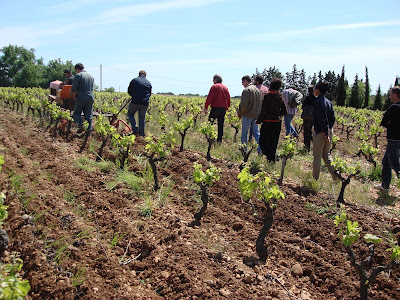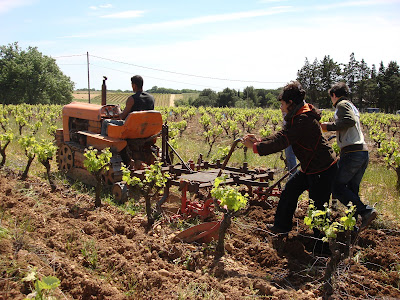
The art of removing weeds and airing the soil without "un coup de roundup." Organic viniculture has to deal with weeds just like everyone else. There are a few different machines available, and techniques considered to do so. The tried and true method involves turning over the soil, ripping up the weeds, and letting them mulch back into the earth. This seems so simple, but in fact, it does require a level of experience and knowledge. First of all, what is the local flora you are combatting? and what are their growing schedules? Which weeds grow when? Which are the main competitors for the nitrogen in the soil? There are optimal times during the growing season plough between the vineyard rows, and each vintner needs to learn to see and understand his own vineyard.

For the many vintners considering changing to organic practices, this is a daunting practice. Rather than go through and spray an ever so minimal (or not) touch of the herbicide Roundup, they need to physically remove the weeds. What are they getting themselves into? Many have adopted the tactic of leaving grass between the vineyards, in a row down the middle, simply mowing it. This gives a "greener" impression to the passing viewer, and it is relatively simple to maintain. These vineyards are easy to identify by the barrenness at the foot of the vines, beside the greenery in the middle. Orchards are also adopting this practice. And those doing so feel quite content that they are doing their best to work within a range of "reasonable agricultural" practices, that are not too onerous, and better than their fathers did before them.

Vineyards treated with a touch of Roundup
JP organized a day of discussions and practical hands-on time on ploughing and weed-removal. Alongside a couple of experienced researchers in the field, they presented the current options for weed control, and the machinery available.
There are experiments ongoing working with clove oil and lemon grass amongst other natural herbicides, though these are not as yet approved in the organic labeling strictures. There are those who contemplate planting non-competitor plants between the vines, hoping these will deter those plants that fight for the nitrogen and deplete the vineyards. There are also those who are trying to simply mow between the vineyards, and not remove any of the weeds -- however, the experts were quick to point out that within the three years, the production level in these vineyards is dramatically depleted, the vines being unable to compete alongside such a profusion of greenery. So unless you have extremely rich soil and rainfall, this is not a truly viable option.

One of the worries when shifting from an herbicide solution to ploughing, is to go it slowly and with the tools adapted to the purpose. If you've not ever ploughed your vineyards, it is likely that the vine roots are close to the surface. Going at these with a blade that cuts 15 centimeters into the soil could kill your vines. Thus, perhaps the solution of brushing? or a shallower blade? or maybe covering the ground with plastic or other material ground-cover -- an expensive and time-consuming solution, but a good one for the first three years of conversion to organic.

JP explained that ploughing also follows a pattern: remove the ground from the base of the vines towards the middle of the rows. Follow this with a pass through the vineyards to even out the surface; then go through and turn the ground from the middle of the rows back over towards the base of the vines; make a pass through to flatten out the ground. Repeat as necessary.

JP's preferred method requires two people: one to drive the tractor, one with the plough in his hands, pushing and pulling around the base of the vine. A quick observation of his mechanical method versus a far more pricey hydraulic machine, proved that perhaps, the salary of that individual assuring a cleaner removal from behind, is perhaps equivalent to the more expensive machinery -- which requires more expensive repairs. The former seemed to do a better job of truly removing the weeds from around the vine itself. Whereas the hydraulic machine left enough that an individual would need to go back through and physically remove the remaining weeds.

So, a return to the basics of pre-war? and why not?
No comments:
Post a Comment